[/caption]
Scientifically speaking, where is the best place on the Moon to set up a colony for research? Hands down, it has to be the Moon’s south pole. Mountainous areas near the rim of Shackelton Crater provide areas of almost continual sunlight, meaning solar power would be constantly available. In addition, the shadowed craters are in constant darkness and may hold water ice, a potential water supply that would be a vital resource for any lunar base. Plus it would be a great place to set up a lunar telescope. Recently, three-dimensional views of this region were released by the European Space Agency, taken by the SMART-1 spacecraft, providing unprecedented details of what has been called the “Peak of Eternal Light.” Moon base designers, take a look…
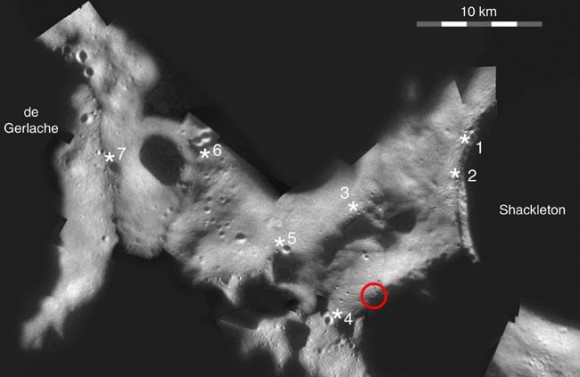
This image from the Clementine mission shows seven possible colony sites on the Moon’s south pole. Circled in red the highest mountain, the so-called “Peak of Eternal Light.”
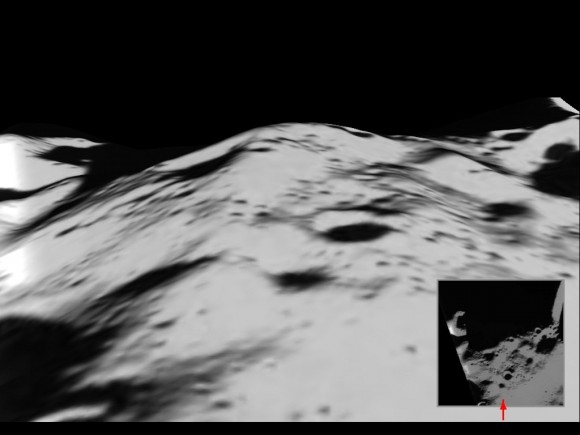
The images were taken by the AMIE camera on board the SMART-1, which has since plunged into the moon’s surface in a planned crash in 2006. The camera team has been working with the data to create digital elevation model of the peaks.
“AMIE is not a stereo camera, so producing a 3-D model of the surface has been a challenge,” said researcher Dr. Detlef Koschny. “We’ve used a technique where we use the brightness of reflected light to determine the slope and, by comparing several images, put together a model that produces a shadow pattern that matches those observed by SMART-1.”
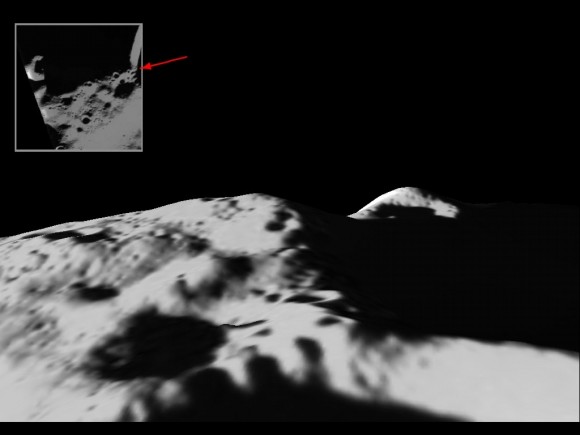
AMIE took a total of 113 images of the peak, located close to the rim of the Shackleton Crater. The team, led by Dr Bjorn Grieger of ESA’s European Space Astronomy Centre in Madrid, took five of the best images showing the peak illuminated from different angles. They mapped all the pixels onto a grid, defining the bright and dark areas. The data from the five images were then compared to produce estimates of the slope angles and the rendered elevation model was iteratively adjusted to produce a shadow match. The original AMIE images were then projected onto the retrieved model. To clearly visualise the topography, the elevation has been exaggerated five times. Here’s the elevation map:
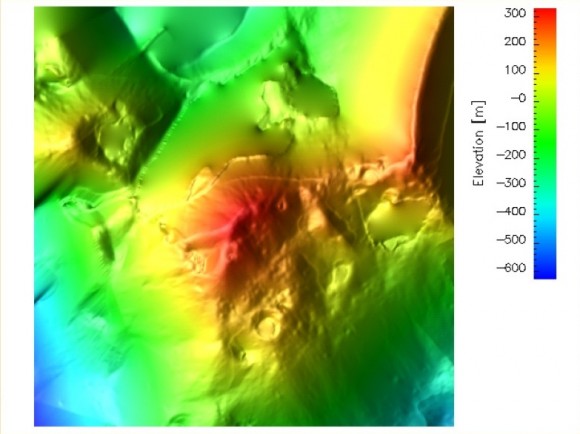
Who’s ready to go?
Source: Europlanet Conference

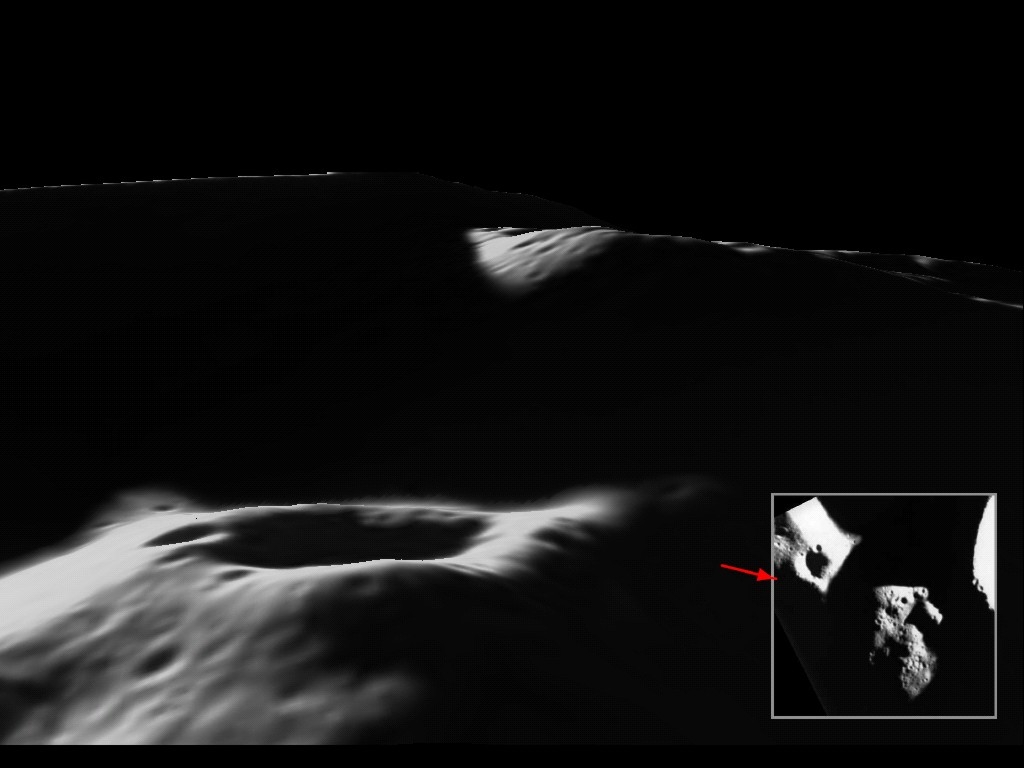
I read an article once about the amount of static electricity the moon has at certain points of the day. Is it because of the sun light and if so would that damage communications in any way or is it something else?
(The article was a bit confusing on what actually caused it.)
Sweet! Can’t wait for SELENE to image this area!
I’m ready to go. Nice little studio apartment, some underground caverns for sportflying a’la Heinlien and of course, an all-terrain rover… with an Earthroof!
The perpetually dark areas would provide a nice haven from solar storms.
I really love these stories that tell of how scientists work to wrest every single piece of information from their data. Few people are that thrifty.
Is there anything like these features at the other end? It’d be nice to have a good view of the entire sky (if/when we get there …).
Could Earth-shine be a problem for a telescope in the crater?
all of those craters in the pics are a sober reminder of what would eventually happen to any surface-based facility.
Kevin F. Says: “The perpetually dark areas would provide a nice haven from solar storms.”
Free electrons in the solar wind charge up the moondust. So should there not be a potential difference to the shadowed inside of the craters at the south pole? And if so, then could this potential difference maybe be used as a “natural” source for electrical power for a moon base?
Does anyone know if the site takes into account frequent meteor collisions that could at least partially if not entirely destroy a moon base?
If your operating a base for a few weeks or months, I doubt meteorites would be a serious risk. Especially if there is an earth return vehicle propped up next door.
If your talking about a permanent base set to last years and keep staff safe even between flights… I’d think you’d want to go underground.
It would take quite a hefty rock to get you just 10 feet underground. The only problem is getting a base into the dirt with that razor sharp powder all over the place.
Maxwell is correct — a temporary base would be at less risk, while a permananet one at more. A future permanent base will therefore have to take into account the existing lunar terrain.
Like on Earth, there are expected to be areas where dried-up lava tubes (rilles) hundred’s of km long, as well as huge volcanic gas blister domes underneath the lunar surface, have left behind huge, huge caverns (some from 20 – 50 km in diameter).
These would make ideal locations for a future base, if not a future lunar city, and would, at most, give some protection.
While meteroid/asteroid activity at the Moon would be at a higher risk of actual impacts occurring (that is, unlike Earth, its lack of atmosphere means everything gets through), there still is no way of avoiding an meteroid/asteroid if it is heading towards the Moon (or, Earth also).
The risks, therefore, exist all the time — for a base whether above or underneath the suface.
If we were to adopt a risk-free approach to setting up a base on the Moon, then we wouldn’t get anywhere.
In fact, look at all the risks others have taken in the Apollo era to get us where we are today. True heros all yesterday, true heros all tomorrow!
Here I Am!
If anything, they should built a portable base.
Surely it wouldn’t be that hard for them to construct a crawler of sorts, 4 of them together to hold a base in the center.
It would be like a small bus, but with spider crawlers where the wheels would normally be.
That, combined with scanner(s) to detect any incoming objects should be enough i think.
Perhaps those attempts to recreate an EM field around them could help too.
But in saying that, i doubt it would help much, or be strong enough to fight off even the worst storms. (look at Earth, it can barely defend itself against them)
Perhaps a donut-shaped habitat would be better, with the generator in the center. (since as we know, the field won’t be perfect, as we see on Earth via Auroras)
Ah who knows, this’ll probably not happen till 2050, what with all these delays and stuff…
Well, the risks of an asteroid hitting a moon base are relatively low, even without atmosphere. There just isn’t all that many stuff around. Which is why, BTW, we can have a working space station in Earth’s orbit for years without any significant impact.
Naturally, they grow as the base gets bigger and the occupation time gets longer. But I’d wager you could have a moon base in place for decades or even perhaps centuries without being hit by anything larger than dust.
The down side to it is that probabilities are probabilities. A moonbase could remain untouched for millenia, but it could also be destroyed the very day it’s settled. There’s most certainly a risk to it…
The north pole would be better IMO. The water concentration is ten times higher.
Is it just me, or does that crater really look like the Apple logo in the 1st overhead image. Isn’t that taking corporate sponsership a bit far? 😉
Very interesting article. I feel it necessary to continue to expand our research and colonize the moon. Think of the possibilities. The real question though is who truly owns the moon (this blog talks about that http://www.ootwo.com/blog/post/2008/05/Trespassing-on-the-Moon-and-other-celestial-bodies.aspx) and who wants to go golfing (www.ootwo.com/moon.asp)?
I would like to see this hapen. If we could travel to the moon almost 40 years ago why woldn’t it make sence to have some kind of space station there. The reserch that could hapen and the study of Luna would be awsome. Also it could be the hub for all who “own” property on the surface.
I have some property and have bought a golf trip on Lunar Links and am looking forward to getting my tee time. For any of you that don’t have a tee time from Lunar Links go to the newest craze in intergalactic sports. The web ste is http://www.ootwo.com I have all the certs. Golfing, Sandsurffing Fishing on the ice caps of Europa and the best one is the Mountain climb on Olypus Mons real cool. Go get yours. I hope that Nasa or whom ever gets there first makes enough room for all of us
Anyone who would order some one to land in a old volcano tube is using poor judgement !
There has be be better place than that up their !
How are those fotos considered 3D? Good sharp fotos but not 3 D on my computer, not even with blue/red glasses.
Reading Dr. Koschny’s paper, SMART-1 only gathered 7 images during the worse case lunar day (their winter). It is hard to extrapolate the status of “Peak of Eternal Light” based on this. His paper even is entitled “Investigating a peak of (almost) eternal light close to the lunar south pole with SMART-1/AMIE images”. This “almost eternal” term is quite oxymoronic.
There are no “peaks of eternal light” at the lunar poles regardless of the hype.